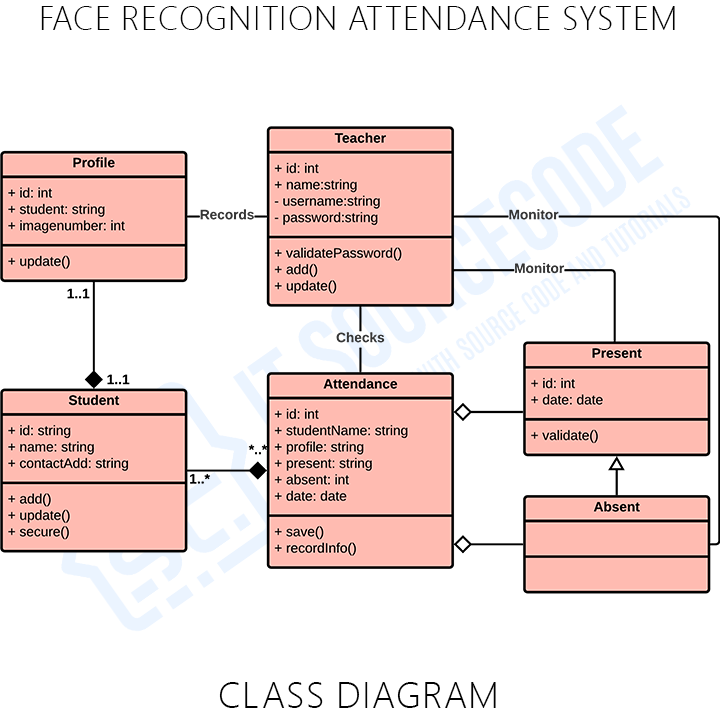Face Recognition System Class Diagram
A class diagram is used to represent, explain, and document the parts (classes) of an face recognition attendance system. It can also be a reference or way to create executable software code.
Class diagrams provide an overview of the system’s classes, functions, and relationships.
Project Overview
| Name: | Face Recognition Attendance System Class Diagram |
| UML Diagram: | Class Diagram |
| Users: | The Company, Employers, and Employees (Business) School, Faculty, and Studrnts (Institution) |
| Tools Used: | Diagraming tool |
| Designer: | ITscourcecode.com |
What is a Face Recognition Attendance System?
Businesses and other establishments use a face recognition system as a tool for various purposes. Some use this software for checking attendance and others use it for tracking the person who enters and exits the establishment.
The Government also utilizes a face recognition system to trace faces known for illegal activities. Therefore, the software is very helpful for every user and in every way.
UML Class Diagram for Face Recognition Attendance System
The UML class diagram is similar to a flowchart in which classes are represented by boxes with three rows inside. The top rectangle holds the class’s name; the middle rectangle contains the class’s properties, and the bottom row contains the class’s operation (methods).
The class diagram is one of the most useful forms of UML diagrams because it elaborates the system’s structure by representing its classes, characteristics, processes, and object relationships.
Face Recognition Attendance System Class Diagram
This simple class diagram gives you the exact details about the system’s class characteristics and methods. It also clarifies the connections of classes in the system.
Here, I will be showing you the sample constructed class diagram provided with its attributes and methods. This is from the simple idea of the face recognition attendance system’s common function.

The illustration shows a simple idea of how the class diagram works. It resembles a flowchart in which classes are present in boxes with three rectangles in each. The top rectangle has the class’s name; the middle holds the class’s properties, and the bottom contains the class’s methods.
The classes identified for Face Recognition Attendance System were the profile, teacher, student, attendance, present, and absent. Their roles are in the middle part and called their attributes. The function of each class is in its’ methods.
You can edit this diagram and it is up to you how will you create your class diagram. However, you need to be precise with your information and consider the decisions included.
Downloadable Pdf File
How to Draw a Class Diagram?
Time needed: 1 minute
Steps in creating Class Diagram for Face Recognition Attendance System.
- Step 1: Familiarize Class Diagram Components
Class Diagram Components are used to create class diagrams. They play a big role in building the class diagram.
To plot the class diagram you will need the class name, its attributes, methods, and their access (visibility). You will base the diagram on the evaluated information to have the exact Class Diagram. - Step 2: Determine the targeted users
Classes are the main part of the diagram and it is presented in a box with three main partitions. It should be declared properly because it could be converted to codes.
- Step 3: Analyze the activities included
Attributes of a class should be placed in the middle part of a class. They were then assigned visibility symbols. This visibility has something to do with the codes.
The operations will be placed at the bottom of a class and represent the functions of a class within a system. - Step 4: Plot the Class Diagram
To map the relationship between the classes, you also need to know the meaning of the symbols at the end of each line that connects them. The ends represent different meanings and relations between two or more classes.
Conclusion
The class diagram is a modeled diagram that explains systems classes and relationships. It can depict the names and attributes of classes, as well as their links and methods that make up the software.
Moreover, the class diagram is the most essential type of UML diagram and is critical in software development. It is an approach to showing the system’s structure in detail and part by part.
Related Article:
Inquiries:
If you have inquiries or suggestions about the Class Diagram discussion, leave us your comments below. We would be glad to hear to concerns and be part of your learning.

